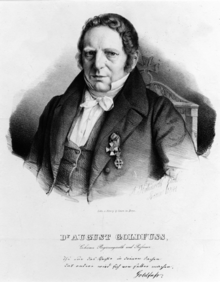Georg August Goldfuß (18 April 1782 – 2 October 1848) was a German palaeontologist, zoologist and botanist. He became a professor of zoology at the University of Erlangen and later at the University of Bonn. He coined the terms "protozoa" and "pelecypoda".
Georg August Goldfuß
| |
|---|---|

Georg August Goldfuß; by Adolf Hohneck (1841)
| |
| Born | (1782-04-18)18 April 1782 |
| Died | 2 October 1848(1848-10-02) (aged 66) |

Goldfuß was born at Thurnau near Bayreuth. His father, a court physician, Johann August Goldfuß (1748–85) died in an accident on a voyage to the East Indies. His mother Margarete née Waechter died in 1799. After studies at the Latin school in Thurnau, he went to study medicine in 1800 first at Arzberg and then at the Collegium Medico-chirurgium in Berlin. At Berlin he was influenced by lectures by Carl Ludwig Willdenow (1765-1812). He received a scholarship from the Prussian government, and he dedicated his thesis to the officer Karl Freiherr vom Stein zum Altenstein (1770-1840). He completed his doctorate at Erlangen in 1804 with a thesis on South African beetles. He worked briefly at the natural history collection in Erlangen but lost the position after the French invasion of 1806. He edited the magazine Politische Zeitung, and in 1808, he was a founder of a medical law firm in Erlangen. After serving as a private tutor for Baron Winkler von Mohrenfels in Helmhofen he considered moving to Calcutta, but this was scuttled by a blockade imposed by Napoleon. Following the vacancies created by the death of his teachers Johann von Schreber (1739-1810) and Eugen Esper (1742-1810), he worked as a lecturer in zoology from 1811 and became professor of zoology at the University of Erlangen. He was admitted to the Leopoldina Academy in 1813. In 1818, he moved to the newly established Rheinische Friedrich-Wilhelms-Universität Bonn where he was involved in establishing a natural history museum. He took a keen interest in fossils and introduced the term protozoa in that year although he included not just single-celled organisms but included polyps, bryozoans and rotifers.[1] He was subsequently appointed professor of zoology and mineralogy at the University of Bonn. Aided by Count Georg zu Münster, he issued the important Petrefacta Germaniae (1826–44), a work which was intended to illustrate the invertebrate fossils of Germany, but it was left incomplete after the sponges, corals, crinoids, echinoderms and part of the mollusca had been figured.[2] A collection of Goldfuß' botanical specimens are housed at Bonn University.[3][4] 06.04.2024)
Goldfuß married Eleonore Oelhafen (1789-1873) in 1815 and they had five sons and six daughters. One of his sons, Otto Goldfuß (1831-1905), became a malacologist. He received an Order of the Red Eagle III Class from the Prussian empire in 1822. He was a Freemason and a member of the Lebanon lodge of Erlangen. He built a large home Rosenburg in Kessenich, Bonn.[2] He suffered from chest disease from 1847 and died from a stroke. He was buried in Poppelsdorf. A street in Bonn was named after him.[5]
Attribution: